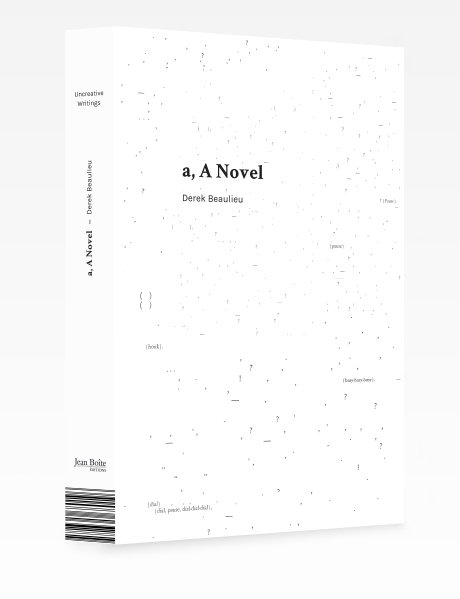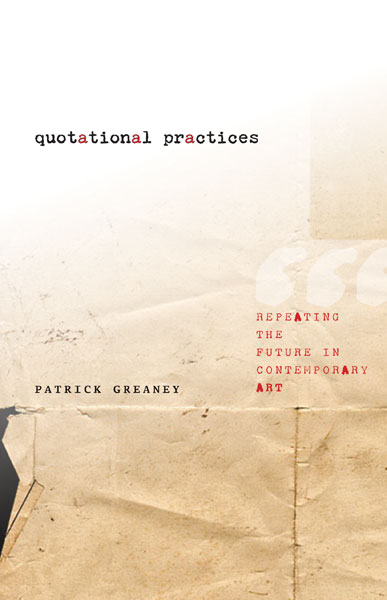Derek Beaulieu: a, A Novel (2017)
Filed under artist publishing, poetry | Tags: · conceptual writing, uncreative writing, visual poetry

“Derek Beaulieu’s a, A Novel is an erasure-based translative response to Andy Warhol’s eponymous novel. Beaulieu carefully erases all of the text on each page of the original work, leaving only the punctuation marks, typists’ insertions and onomatopoeic words. The resultant text is a novelistic ballet mécanique, a visual orchestration of the traffic signals and street noise of 1960’s New York City. This visually powerful half score/half novel highlights the musicality of non-narrative sounds embedded within conversation.
Published in December 1968, Andy Warhol’s a, A Novel consists solely of the transcribed conversations of Factory denizen Ondine (Robert Olivo). Ondine’s amphetamine-addled conversations were captured on audiotape as he haunted the Factory, hailed cabs to late-night parties and traded gossip with Warhol and his coterie. The tapes were roughly transcribed by a small group of high school students. Rife with typographic errors, censored sections, and a chorus of voices, the 451 pages of transcription became, unedited, “a new kind of pop artefact”. These pages emphasize transcription over narration, hazard over composition.
In his book, Derek Beaulieu offers a radical displacement of Andy Warhol’s work. He erases the novel’s speaking characters – members of the mid 1960’s New York avant-garde – and preserves only the musicality of their conversations. Beaulieu perfectly provides a tangible example of Theodor Adorno’s theory elaborated in his essay ”Punctuation Marks”, in which he argues that punctuation marks are the “traffic signals” of literature and that there is “no element in which language resembles music more than in the punctuation marks”.
This visual poetry is accompanied by an essay by Gilda Williams, “Breaking Up is Hard to Do. Men, Women, and Punctuation in Warhol’s Novel a”. Her deep knowledge of both Andy Warhol’s work and the history of contemporary art explores the complicated history of the original novel and highlights the urgent and precise spirit of Derek Beaulieu’s work—the work of an artist who situates Uncreative Writing at the core of contemporary literature and artistic labour.”
Publisher Jean Boîte Éditions, Paris, 2017
ISBN 9782365680196
478 pages
via author
PDF (24 MB)
Comment (0)Patrick Greaney: Quotational Practices: Repeating the Future in Contemporary Art (2014)
Filed under book | Tags: · appropriation, art criticism, authorship, conceptual writing, literary criticism

“Literature and art have always depended on imitation, and in the past few decades quotation and appropriation have become dominant aesthetic practices. But critical methods have not kept pace with this development. Patrick Greaney reopens the debate about quotation and appropriation, shifting away from claims about the death of the author. In interpretations of art and literature from the 1960s to the present, Quotational Practices shows how artists and writers use quotation not to undermine authorship and originality, but to answer questions at the heart of twentieth-century philosophies of history.
Greaney argues that quotation is a technique employed by art and philosophy to build ties to the past and to possible futures. By exploring quotation’s links to gender, identity, and history, he offers new approaches to works by some of the most influential modern and contemporary artists, writers, and philosophers, including Walter Benjamin, Guy Debord, Michel Foucault, Marcel Broodthaers, Glenn Ligon, Sharon Hayes, and Vanessa Place.
Ultimately, Quotational Practices reveals innovative perspectives on canonical philosophical texts as well as art and literature in a wide range of genres and mediums—from concrete poetry and the artist’s book to performance, painting, and video art.”
Publisher University of Minnesota Press, 2014
ISBN 9780816687343, 081668734X
xiv+217 pages
Reviews: Laura Guy (Visual Studies, 2015), Adam Barbu (Rev Cult Theory, 2016).
PDF (25 MB)
Comment (0)Amodern, 6: Reading the Illegible (2016)
Filed under journal | Tags: · conceptual writing, literature, poetics, poetry, reading

Amodern is a peer-reviewed, open-access scholarly journal devoted to the study of media, culture, and poetics.
The collective aim of contributions to this issue is “to imagine, in a scholarly or para-scholarly fashion, what we could explore, as writers and artists, if we took seriously the potential poetics of illegibility as a weird sub-category of the legible.”
With contributions by Nick Thurston, Johanna Drucker, Michael Cronin, John Mowitt, Garrett Stewart, Diana Hamilton, Kate Briggs, Matt Applegate, Stephen Voyce, and Luke Skrebowski.
Edited by Nick Thurston
Publisher Concordia University and Lakehead University, July 2016
Creative Commons Attribution 3.0 Unported License

